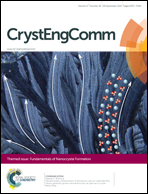Molecular modeling of (10![[1 with combining macron]](https://www.rsc.org/images/entities/char_0031_0304.gif) 0) and (000
0) and (000![[1 with combining macron]](https://www.rsc.org/images/entities/char_0031_0304.gif) ) zinc oxide surface growth from solution: islands, ridges and growth-controlling additives
) zinc oxide surface growth from solution: islands, ridges and growth-controlling additives
Abstract
The mechanism of (10![[1 with combining macron]](https://www.rsc.org/images/entities/char_0031_0304.gif) 0) and (000
0) and (000![[1 with combining macron]](https://www.rsc.org/images/entities/char_0031_0304.gif) ) zinc oxide surface growth from ethanolic solution is investigated by molecular simulation. Growth steps are modelled at the maximum level of detail, i.e. by association of individual Zn2+ and OH− ions. Apart from structural relaxation, a mixed quantum/classical approach is used to explicitly study the proton-transfer reactions during crystal growth. Starting from idealized surfaces, we find that the (000
) zinc oxide surface growth from ethanolic solution is investigated by molecular simulation. Growth steps are modelled at the maximum level of detail, i.e. by association of individual Zn2+ and OH− ions. Apart from structural relaxation, a mixed quantum/classical approach is used to explicitly study the proton-transfer reactions during crystal growth. Starting from idealized surfaces, we find that the (000![[1 with combining macron]](https://www.rsc.org/images/entities/char_0031_0304.gif) ) face evolves into rough landscapes composed of small islands separated by ~1 nm. On the other hand, the (10
) face evolves into rough landscapes composed of small islands separated by ~1 nm. On the other hand, the (10![[1 with combining macron]](https://www.rsc.org/images/entities/char_0031_0304.gif) 0) growth front shows the formation of ridges encompassed by analogous 10
0) growth front shows the formation of ridges encompassed by analogous 10![[1 with combining macron]](https://www.rsc.org/images/entities/char_0031_0304.gif) 0 planes of the wurtzite structure. Contrary to idealized surface models, such rough surfaces obtained from explicit growth simulations enable us to identify considerable differences in both the binding site and energy for the association of growth-controlling additives. Using acetate and citrate ions as examples, we demonstrated the preferential association with peaks and kinks, respectively.
0 planes of the wurtzite structure. Contrary to idealized surface models, such rough surfaces obtained from explicit growth simulations enable us to identify considerable differences in both the binding site and energy for the association of growth-controlling additives. Using acetate and citrate ions as examples, we demonstrated the preferential association with peaks and kinks, respectively.
![Graphical abstract: Molecular modeling of (10 [[1 with combining macron]] 0) and (000 [[1 with combining macron]] ) zinc oxide surface growth from solution: islands, ridges and growth-controlling additives](/en/Image/Get?imageInfo.ImageType=GA&imageInfo.ImageIdentifier.ManuscriptID=C5CE00358J&imageInfo.ImageIdentifier.Year=2015)
- This article is part of the themed collection: Fundamentals of Nanocrystal Formation

 Please wait while we load your content...
Please wait while we load your content...
![[1 with combining macron]](https://www.rsc.org/images/entities/h2_char_0031_0304.gif) 0) and (000
0) and (000